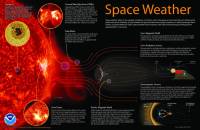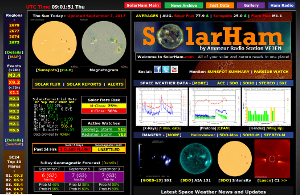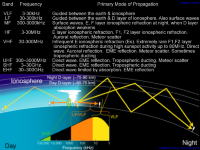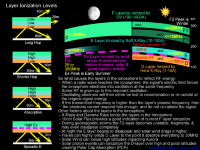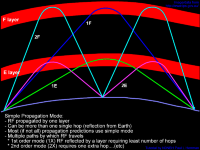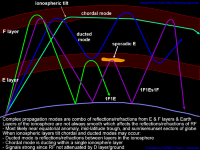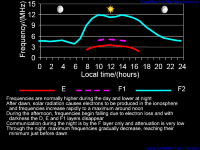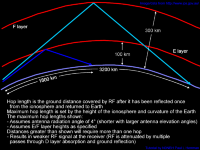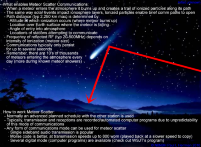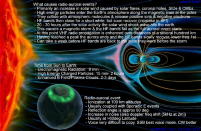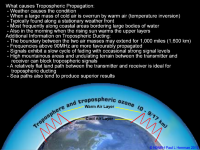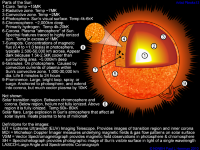HF Radio communications
Space Weather impacts radio communication in a number of ways. At frequencies in the 1 to 30 mega Hertz range (known as “High Frequency” or HF radio), the changes in ionospheric density and structure modify the transmission path and even block transmission of HF radio signals completely. These frequencies are used by amateur (ham) radio operators and many industries such as commercial airlines. They are also used by a number of government agencies such as the Federal Emergency Management Agency and the Department of Defense.
There are several types of space weather that can impact HF radio communication. In a typical sequence of space weather storms, the first impacts are felt during the solar flare itself. The solar x-rays from the sun penetrate to the bottom of the ionosphere (to around 80 km). There the x-ray photons ionize the atmosphere and create an enhancement of the D layer of the ionosphere. This enhanced D-layer acts both as a reflector of radio waves at some frequencies and an absorber of waves at other frequencies. The Radio Blackout associated with solar flares occurs on the dayside region of Earth and is most intense when the sun is directly overhead.
Another type of space weather, the Radiation Storm caused by energetic solar protons, can also disrupt HF radio communication. The protons are guided by Earth’s magnetic field such that they collide with the upper atmosphere near the north and south poles. The fast-moving protons have an affect similar to the x-ray photons and create an enhanced D-Layer thus blocking HF radio communication at high latitudes. During auroral displays, the precipitating electrons can enhance other layers of the ionosphere and have similar disrupting and blocking effects on radio communication. This occurs mostly on the night side of the polar regions of Earth where the aurora is most intense and most frequent.
More information on solar activity from an amateur radio operator’s perspective is available here (pdf)
Report of Solar-Geophysical Activity here
NOAA Space Weather Scales
The NOAA Space Weather Scales were introduced as a way to communicate to the general public the current and future space weather conditions and their effects on people and systems.
Many of the SWPC products describe the space environment, but few have described the effects that can be experienced as the result of environmental disturbances. These scales are useful to users of our products and those who are interested in space weather effects. The scales describe the environmental disturbances for three event types: geomagnetic storms, solar radiation storms, and radio blackouts. The scales have numbered levels, analogous to hurricanes, tornadoes, and earthquakes that convey severity. They list possible effects at each level. They also show how often such events happen, and give a measure of the intensity of the physical causes.
R5 Extreme
HF Radio: Complete HF (high frequency) radio blackout on the entire sunlit side of the Earth lasting for a number of hours. This results in no HF radio contact with mariners and en route aviators in this sector. Navigation: Low-frequency navigation signals used by maritime and general aviation systems experience outages on the sunlit side of the Earth for many hours, causing loss in positioning. Increased satellite navigation errors in positioning for several hours on the sunlit side of Earth, which may spread into the night side. X20 (2 x 10-3) Less than 1 per cycle
R4 Severe
HF Radio: HF radio communication blackout on most of the sunlit side of Earth for one to two hours.
HF radio contact lost during this time.
Navigation: Outages of low-frequency navigation signals cause increased error in positioning for one to two hours. Minor disruptions of satellite navigation possible on the sunlit side of Earth. X10 (10-3) 8 per cycle (8 days per cycle)
R3 Strong
HF Radio: Wide area blackout of HF radio communication, loss of radio contact for about an hour on sunlit side of Earth.
Navigation: Low-frequency navigation signals degraded for about an hour. X1 (10-4) 175 per cycle (140 days per cycle)
R2 Moderate
HF Radio: Limited blackout of HF radio communication on sunlit side, loss of radio contact for tens of minutes.
Navigation: Degradation of low-frequency navigation signals for tens of minutes. M5 (5 x 10-5) 350 per cycle (300 days per cycle)
R1 Minor
HF Radio: Weak or minor degradation of HF radio communication on sunlit side, occasional loss of radio contact.
Navigation: Low-frequency navigation signals degraded for brief intervals. M1 (10-5)2000 per cycle (950 days per cycle)
More information on space weather scales from an amateur radio operator's perspective here (NOAA) and here (pdf)
Radio Communications Dashboard
Geophysical Alert Message
Report of Solar-Geophysical Activity
